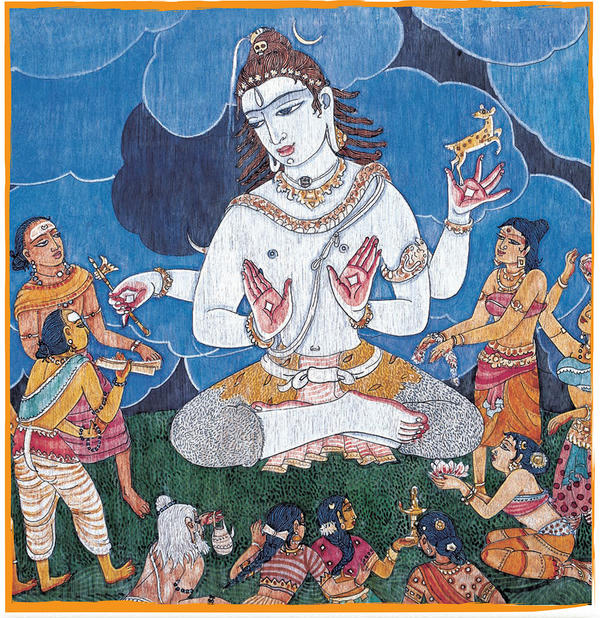17 What Are the Beliefs of Saivism?§
Devotees approach God Siva with offerings of flowers, fruits and love. Others bring petitions and prayers, seeking blessings and guidance on the path. They believe that a heartfelt approach to God will bring contentment, joy and abundance.§
S. RAJAM§
Every religion has a set of core beliefs, called a creed, that summarizes its theology. Children learn the creed of their faith at a young age. By knowing and understanding our creed, we can express our tradition, in basic and consistent terms, to followers of other faiths. The twelve beliefs on the next page capture the main ideas of Saiva Siddhanta, which is one of the six schools of Saivism. They contain our view of God, soul and world, evil, love and more. Beliefs vary greatly among the religions of the world. Our beliefs create our attitudes, and our attitudes influence our actions. Therefore, what we believe shapes our lives, defines our culture and molds our future. Each person’s actions can be traced back to what he believes about himself, other people and the world around him. If those beliefs are correct, his actions will be helpful to others. Consider the belief in God as a loving power flowing through everything. This creates an attitude of respect, kindness and compassion. In contrast, the belief in an evil power, in light forces and dark forces, creates the attitude that it is acceptable to cause pain and injury to those we judge to be evil. Gurudeva explained the power of belief: “The human mind is exactly like a computer. Programs that go in are the beliefs. Their performance is the attitude, and the knowledge or the impetus that passes through both determines the output or the action. Children will learn the basic attitudes from their mothers and fathers by absorbing the beliefs that their mothers and fathers have placed into their subconscious mind, even prenatally. This is the first stage of writing the code, as a programmer would do in creating a new application.”§
Memorize these twelve beliefs. In so doing, you will help to perpetuate Saivism’s culture of devotion, humility, nonviolence, compassion and service.§
GURUDEVA: Historically, creeds have developed whenever religions migrate from their homelands. Until then, the beliefs are fully contained in the culture and taught to children as a natural part of growing up. ... A creed is the distillation of volumes of knowledge into a series of easy-to-remember beliefs, or shraddha.§
A Creed for Saivite Hinduism
1 REGARDING GOD’S UNMANIFEST REALITY: Siva’s followers all believe that Lord Siva is God, whose Absolute Being, Parasiva, transcends time, form and space. The yogi silently exclaims, “It is not this. It is not that.” Yea, such an inscrutable God is God Siva. Aum.§
2 REGARDING GOD’S MANIFEST NATURE OF ALL-PERVADING LOVE: Siva’s followers all believe that Lord Siva is God, whose immanent nature of love, Parashakti, is the substratum, primal substance or pure consciousness flowing through all form as energy, existence, knowledge and bliss. Aum.§
3 REGARDING GOD AS PERSONAL LORD AND CREATOR OF ALL: Siva’s followers all believe that Lord Siva is God, whose immanent nature is the Primal Soul, Supreme Mahadeva, Parameshvara, author of Vedas and Agamas, the creator, preserver and destroyer of all that exists. Aum.§
4 REGARDING THE ELEPHANT-FACED DEITY: Siva’s followers all believe in the Mahadeva Lord Ganesha, son of Siva-Shakti, to whom they must first supplicate before beginning any worship or task. His rule is compassionate. His law is just. Justice is His mind. Aum.§
5 REGARDING THE DEITY KARTTIKEYA: Siva’s followers all believe in the Mahadeva Karttikeya, son of Siva-Shakti, whose vel of grace dissolves the bondages of ignorance. The yogi, locked in lotus, venerates Murugan. Thus restrained, his mind becomes calm. Aum.§
6 REGARDING THE SOUL’S CREATION AND IDENTITY WITH GOD: Siva’s followers all believe that each soul is created by Lord Siva and is identical to Him, and that this identity will be fully realized by all souls when the bondage of anava, karma and maya is removed by His grace. Aum.§
7 regarding THE GROSS, SUBTLE AND CAUSAL PLANES OF EXISTENCE: Siva’s followers all believe in three worlds: the gross plane, where souls take on physical bodies; the subtle plane, where souls take on astral bodies; and the causal plane, where souls exist in their self-effulgent form. Aum.§
8 REGARDING KARMA, SAMSARA AND LIBERATION FROM REBIRTH: Siva’s followers all believe in the law of karma—that one must reap the effects of all actions he has caused—and that each soul continues to reincarnate until all karmas are resolved and moksha, liberation, is attained. Aum.§
9 REGARDING THE FOUR MARGAS, STAGES OF INNER PROGRESS: Siva’s followers all believe that the performance of charya, virtuous living, kriya, temple worship, and yoga, leading to Parasiva through the grace of the living satguru, is absolutely necessary to bring forth jnana, wisdom. Aum.§
10 REGARDING THE GOODNESS OF ALL: Siva’s followers all believe there is no intrinsic evil. Evil has no source, unless the source of evil’s seeming be ignorance itself. They are truly compassionate, knowing that ultimately there is no good or bad. All is Siva’s will. Aum.§
11 REGARDING THE ESOTERIC PURPOSE OF TEMPLE WORSHIP: Siva’s followers all believe that religion is the harmonious working together of the three worlds and that this harmony can be created through temple worship, wherein the beings of all three worlds can communicate. Aum.§
12 REGARDING THE FIVE LETTERS: Siva’s followers all believe in the Panchakshara Mantra, the five sacred syllables “Namaḥ Śivāya,” as Saivism’s foremost and essential mantra. The secret of Namaḥ Śivāya is to hear it from the right lips at the right time. Aum.§


